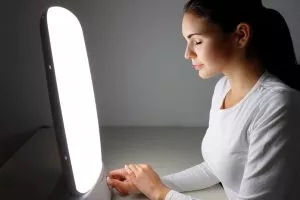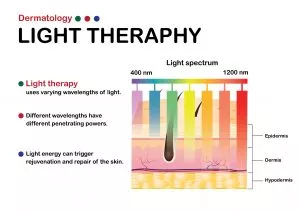At Light Sources and LightTech, through our strategic partnership, we design, engineer and produce fluorescent lamps to meet particular system design requirements, including medical phototherapy lamps.
Fluorescent Lamps for Medical Phototherapy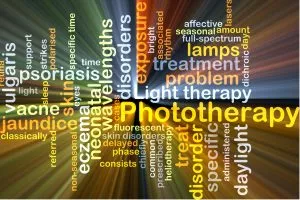
Our specialty fluorescent lamps, LEDs and dichroic lamps are used in many phototherapy applications where light therapy lamps are proven to treat a variety of illnesses and ailments. Light therapies consist of exposure to specific wavelengths of light to treat many medical conditions, such as neonatal jaundice, mood disorders, sleep disorders, wound healing and photodynamic therapy, PDT, a treatment that combines special drugs with light used to kill cancer cells.
Medical phototherapy lamps are proven effective at treating a variety of skin conditions, including:
Phototherapy lamps provide effective, proven treatment for many illnesses and disorders.
Neonatal Jaundice 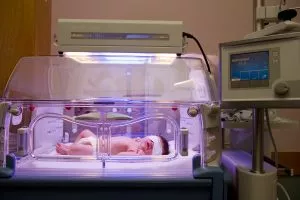
Neonatal Jaundice is a common condition in newborns from immature liver function. As toxins build in the system, the infants take on a yellow coloring of the skin and in the white’s of the eyes. Infants will generally outgrow jaundice, but in some cases, when bilirubin levels in the blood are too high, alternate therapies, such as blue light treatment, are required to prevent brain damage. Our Ultra Blue (also known as Bili) lights in T5, T8 and T12 linear and T6 compact are used in phototherapy for jaundice in newborns. The blue fluorescent “Bili” lamps give off specific wavelengths of blue light that help break down bilirubin into nontoxic substances that can leave the body through the urine and stools.
Mood Related Disorder
Seasonal Affective Disorder (SAD): Light therapy lamps are used for winter blues or SAD, a specific type of major depression that reoccurs at specific times of the year due to reduced levels of daylight. Natural sunlight triggers the pineal gland in our brain to produce serotonin, a mood-elevating hormone. For countries in the northern hemisphere (closer to the North Pole), the onset of SAD comes in autumn as daylight decreases and dissipates in spring when daylight is longer. Depression symptoms can be mild to moderate but can become severe. The most common symptoms include:
- Fatigue
- Lack of interest in normal activities
- Social withdrawal
- Craving foods high in carbohydrates
- Weight gain
For the last several years, the most effective treatment for SAD has been full spectrum light therapy. Most people experience a marked improvement within a week. Full spectrum lighting imitates the color and intensity of the sun at noon. Our full spectrum lamps produce a clear, bright white light with a CRI of 90 to 100 and are made with full spectrum rare earth phosphors. They cover the entire spectrum, from ultraviolet to VIBGYOR (Violet, Indigo, Blue, Green, Yellow, Orange and Red) to infrared. Light therapy has also been proven successful in helping non-seasonal types of depression. Patients treated with light therapy similarly to SAD patients generally show results faster than with the use of antidepressants. Our T5, T8, T12, and CPFL styles of UV depression lamps are used in full-spectrum light-therapy applications.
Sleep Related Disorders
Circadian rhythm sleep disorders safely and effectively aided by high-intensity and full-spectrum light therapy include Jet Lag (desynchronosis), shift work sleep disorders, and other natural sleep disorders. Low-level light at night, thought to be related to simulation of moonlight, also accelerates recovery. Circadian rhythm sleep disorders affect the timing of sleep, as well as other biological functions. Sunlight naturally activates the pineal gland in the brain, which controls melatonin and serotonin production. As daylight diminishes, the production of melatonin increases, causing us to get tired. As daylight approaches, production of serotonin increases, making us more alert. This daily biological schedule is part of our circadian rhythm. Normal biological clock functions allow people to fall asleep and wake up at the same time every day. This is not true for people with sleep disorders. Their sleep and wake patterns differ depending on the type of sleep disorder they have.
People who suffer from Jet Lag are helped with exposure to full spectrum light before, during and after travelling. NASA uses this process to train astronauts for late night launches. Shift Work Sleep Disorder: People who work irregular hours (night and early morning shifts) need to be alert even though the brain is producing melatonin, making the body tired. Symptoms of shift work sleep disorders can be a nuisance and even dangerous, depending on the duties performed. Some symptoms include:
- Wandering and disconnected thoughts
- Headaches or stomach aches
- Drowsiness during shift and inability to sleep after shift
- Inattention to minor but potentially important details
- Degraded mental abilities (including memory, decision-making, and perception)
- Increased distractibility and irritability
Bright light therapy has been used successfully to advance or delay sleep, depending on how the circadian rhythm is shifted. This type of light therapy requires patients be exposed to high intensity light (10,000 lux) for a duration of 30 to 60 minutes at a time, several times a day, before, during and after irregular shifts. The T5, T8, T12, and CPFLs from LCD Lighting are used in applications for sleep disorder light therapy.
Skin Related Disorders
Dermatologists have been treating stubborn skin conditions with broadband phototherapy for over 80 years. Patients have found relief from many diseases and their symptoms, including Psoriasis, eczema, vitiligo, and acne vulgaris.
UV light also provides beneficial effects for cosmetic use.
Psoriasis – UVA, UVB and Narrow Band UVB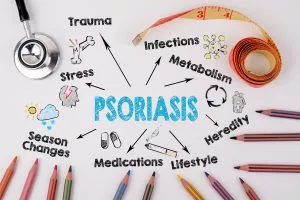
Patients with psoriasis suffer from patches of scaly, dry, itchy skin or skin that is hardened and raised in lesions. While topical ointments are generally sufficient for people with mild to moderate symptoms, they do little to control severe symptoms. UV treatments can help promote healing, decreasing psoriasis symptoms. This form of light therapy slows down the rapid growth of skin cells below the epidermal surface. Doctors apply both UVA and UVB wavelengths in conjunction with a medication called Psoralen. Patients can use photo therapy treatments at home with UVB lights. Skin condition generally improves within a few weeks or months.
Eczema – UVA, UVB and Narrow Band UVB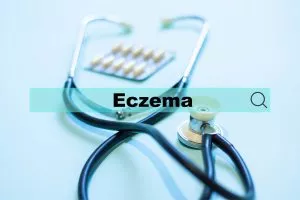
Eczema (atopic dermatitis) symptoms include swollen, reddened and itchy skin and is precipitated by an overactive immune system. UV light suppresses the immune system and reduces inflammation. In conjunction with topical treatments, UVA at a wavelength of 315 to 400 nm, UVB at a wavelength of 280 to 315 nm, and narrow band UVB at a wavelength of 310 nm are used successfully to treat patients with eczema.
Vitiligo – Primarily UVB Narrow Band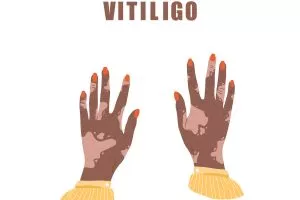
Vitiligo is a condition where a loss of melanin leaves white patches on the skin. Possibly an autoimmune condition, the body’s immune system attacks and destroys melanocytes (pigment-forming cells). Due to its safety and efficacy, narrow band UVB lamps for vitiligo are becoming a popular method in treating the disorder. Narrow band UVB light helps to repigment cells.
Acne Vulgaris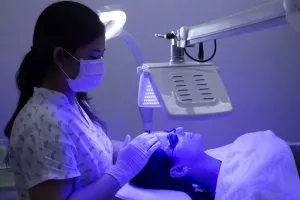
Acne vulgaris is persistent and annoying, affecting approximately 60 million Americans of all ages and races. Sixty-five percent of acne suffers are between 14 and 24, while twenty percent are adults. Twenty million Americans have acne severe enough to cause scaring. The condition is so troubling to people suffering from it that over 16% of the 3.3 billion dollar skincare market is spent on fighting acne. Still, many patients find that topical and oral treatments only minimize symptoms, and laser therapy is painful. In addition, many common ointments, such as benzoyl peroxide, are harsh and drying and disrupt the natural pH balance of skin; initially, they might clear mild acne but follow-up breakouts occur from dry and improperly balanced skin. Many treatments are ineffective against painful boils and stubborn Propionibacterium acnes (p. acne).
A combination of blue and red light therapy has been successful at treating acne without the painful or annoying side effects of other acne treatments. When the body’s immune system attacks bacteria in the skin’s pores, the surrounding skin becomes red and inflamed. The result is commonly called a pimple. Blue light UV acne lamps, at a wavelength of 415 nm, has an antibacterial effect. The light penetrates the skin, killing existing bacteria and preventing future breakouts. Red light, at a wavelength of 600 nm – 700 nm, soothes inflammation and stimulates cell regeneration, repair, and healing.
Wound Healing
Many medical conditions, such as diabetes, poor circulation, and bed sores, can cause wounds that remain open. Infrared light releases nitrous oxide in the blood stream, increasing blood circulation in the area where the light is directed (i.e. the wound). Red light, at a wavelength of 600nm to 700nm, releases cytokines, which stimulate fibroblast proliferation and the production of growth factors for improved healing and wound repair.
Photodynamic Therapy (PDT)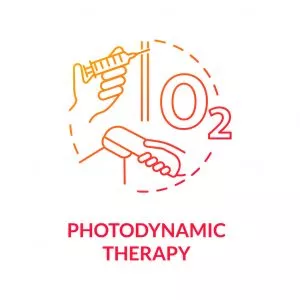
Photodynamic therapy (PDT) is a medical treatment with a photosensitizing drug that becomes activated by light exposure to the applied drug. PDT is currently used in oncology, dermatology, and cosmetic surgery. PDT uses blue light to kill the cells of tumors or atypical growths close to the surface of the skin; it is also used for sun damage, cosmetic skin improvement, oily skin, enlarged sebaceous glands, rejuvenation (anti-aging), and many other skin conditions. More recently, the FDA has approved its use for non-small cell lung and esophageal cancer and precancerous changes of Barrett’s esophagus. Our T5, T8, T12, and CPFL lamp types are used in PDT light therapy treatments
LightSources and LightTech are world leading suppliers of fluorescent and UV lamp solutions including germicidal and medical phototherapy lamps. We employ the most advanced, high-tech lighting engineers in the industry, offering custom design and engineering with custom phosphor blends to meet specific customer requirements. Contact us to learn about our many medical phototherapy lamp solutions.
LAMP PRODUCT DATA:
UV Germicidal LampsLAMP APPLICATIONS:
UV Germicidal Applications
Click here to download the Spectrum Graphs & Action Curves of our medical phototherapy lamps. For further specification sheets, download the following PDF files:
LCDL_MedSun Therapy Wide Band UVB 36W Compact
LCDL_MedSun Therapy Wide Band UVB 25W
LCDL_MedSun Therapy Wide Band UVB 20W
LCDL_MedSun Therapy Wide Band UVB 36W Compact
LCDL_MedSun Therapy Wide Band UVB 25W
LCDL_MedSun Therapy Wide Band UVB 20W
LCDL_MedSun Therapy Wide Band UVB 15W
LCDL_MedSun Therapy Wide Band UVB 100W
LCDL_MedSun Therapy PUVA 36W Compact
LCDL_MedSun Therapy Narrow Band 9W Compact G23
LCDL_MedSun Therapy Narrow Band 9W Compact 2G7
LCDL_MedSun Therapy Narrow Band UVB 15W
LCDL_MedSun Therapy Narrow Band UVA 36W Compact



